Wed 19 Oct 2011
A Movie Review by Dan Stumpf: RIDE THE PINK HORSE (1947).
Posted by Steve under Crime Films , Reviews[6] Comments
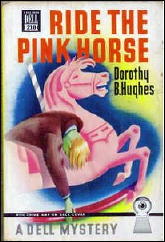
RIDE THE PINK HORSE. Universal, 1947. Robert Montgomery, Thomas Gomez, Rita Conde, Iris Flores, Wanda Hendrix, Fred Clark, Andrea King, Art Smith. Screenplay: Ben Hecht & Charles Lederer, based on the novel by Dorothy B. Hughes. Director: Robert Montgomery.
Starring and directed by Robert Montgomery, Ride the Pink Horse is not a great film by any means, but interesting throughout. Montgomery had, by all accounts, an unusually high IQ, and it has always seemed to me that his films are all marked by an almost intangible quality of Intelligence.
The failures as well as the successes seem to presuppose a certain degree of Smarts on the part of the movie-going audience (a classically underestimated group) and work from there.
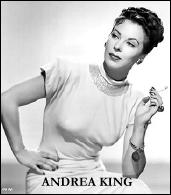
The well-known extended subjective camerawork in Lady in the Lake, for example, is hardly an unqualified triumph, but it’s the sort of thing somebody had to try sooner or later; all it took was a director who had some confidence in his audience.
Likewise the sly references in Montgomery’s autobiographical daydream-movie Once More, My Darling, where Ann Blyth conveys a hitherto-unsuspected and startling sensuality while we wait for things to get funny, which they never really do.
Montgomery’s intelligence often showed itself even in films he didn’t direct but merely acted in. There’s his effete quisling in The Big House; the blandly ingenuous psycho in Night Must Fall; the Detective/Prince in Trouble for Two; and the memorable Here Comes Mr. Jordan and They Were Expendable, all films marked by much more thoughtfulness than is common in movies of their sort.
Oddly enough, it’s this very intelligence that mitigates against Ride the Pink Horse, in which Montgomery portrays Lucky Gagin, a not-too-bright petty crook out for revenge against Fred Clark as a murderous Political Boss; he just never convinces us that he’s as dumb as his character is supposed to be.
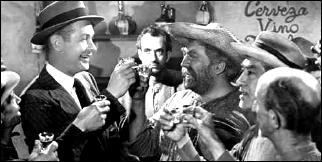
Montgomery walks and talks just like a pug throughout the film, but every so often he visibly relaxes and just listens while another character talks, and in these moments his face betrays him with a perceptive, alert expression that all the Dis ’n’ Dats in his dialogue just can’t hide.
What we have here is an educated man playing a Dummy, and for all his brains, Montgomery just ain’t a good enough actor to hide it.
I should go on to add, though, that except for this, Ride the Pink Horse is just about everything you could want in a film noir and more, with moody lighting, long, expressive takes, a host of skillfully limned minor characters, and the showy stylistic flourishes one expects from this genre.
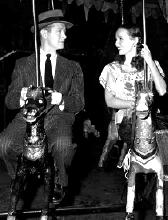
Yet even the standard film noir brutality takes an oddly thoughtful turn here: for though the Good Guys in this movie take an awful lot of physical abuse — very graphically portrayed — the Baddies get their lumps off-camera, if at all.
And this is not a small point when you’re talking about film noir. One of the staples of Classic noirs no one ever mentions is that grin of Guilty Pleasure lighting the features of Bogart, Powell, et al. as they prepare to deliver a well-deserved ass-kicking to their erstwhile tormentors.
Nothing like that ever happens in Ride the Pink Horse, as if Montgomery were trying to subtly convey that violence is, after all, the province of the Bad Guys, and we grown-ups must look elsewhere for catharsis.
Hmm. Bob Montgomery may not be the best movie-maker ever, but he maybe deserves more attention than he’s getting.
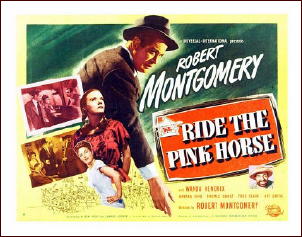
October 19th, 2011 at 6:19 pm
Many years ago I caught cold or the flu during Spring break while I was a young reference librarian at St. Olaf College and I spent about a week recuperating in my apartment. Ar the beginning of that week I watched Ride the Pink Horse on TV one afternoon. The film has stuck with me ever since even though I had no further occasions to see it. Last summer I acquired a copy of it on DVD and decided to watch it again, but not until after I had read the novel. Both experiences were interesting. I agree, it is not a great film, but for me it has its moments.
October 19th, 2011 at 6:23 pm
One big mystery one might ask about is, Why has there been no commercial release of this film?
(If I’m wrong, let me know.)
October 20th, 2011 at 6:24 pm
Another film based on anovel by Dorothy Hughes is a masterpiece: In a Lonely Place, with one of Bogart’s best performances.
October 21st, 2011 at 6:17 am
I agree about IN A LONELY PLACE, one of my favorite Bogart films.
Reading about RIDE THE PINK HORSE made me dig out my VHS bootleg tape and watch it again. Excellent film noir and there must be some reason why it has not been officially released. Even back in the 1980’s and 1990’s I wondered about this and that’s why I managed to find a copy on tape. I see there are alot of different sources offering it on dvd also.
October 25th, 2011 at 8:21 pm
I stumbled across RIDE THE PINK HORSE while in high school during the late ’60s, and I liked it immediately. So much so, in fact, that when I began collecting 16mm movies in the early ’70s, it was either the third or fourth feature film I purchased. (To be honest, I prefer it to the Hughes novel.) Years ago, while covering the home-video industry for various trade journals, I enjoyed a good relationship with Universal’s corporate vp of public relations and put in good words for favorite titles I wanted to see in release. She relayed my requests, all of which were deemed too obscure to appeal to today’s consumers. But in recent years some of them have finally been issued, so I remain hopeful PINK HORSE will eventually surface on DVD.
May 12th, 2014 at 9:43 am
I know this review was posted some years ago, but what a perceptive take on the underrated Robert Montgomery! Undoubtedly intelligent and ambitious, both in front of, and behind the camera. (Although in “Here Comes Mr. Jordan,” he certainly convinces as an uneducated (but good-hearted and perceptive) boxer. “Ride the Pink Horse” is just the sort of near-cult item that could be released as an On-Demand DVD (Montgomery’s “The Gallant Hours” has been released this way). I can understand that it’s not economical for a studio to do a full restoration on these sort of movies, but there’s plenty of fans to pay a higher price for a straight DVD-R burn of a decent print!